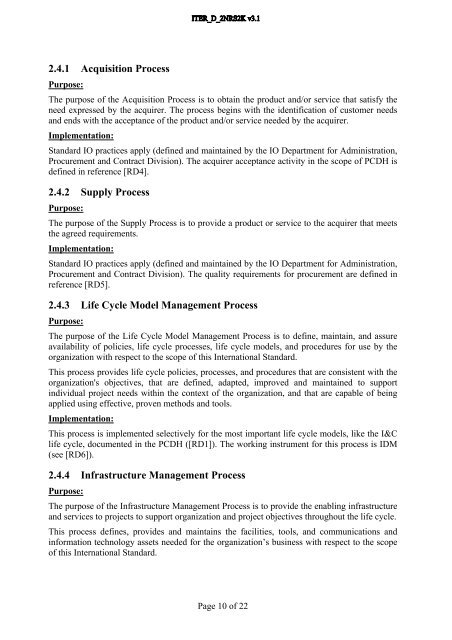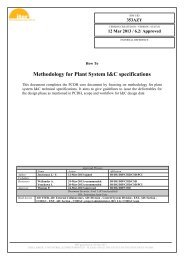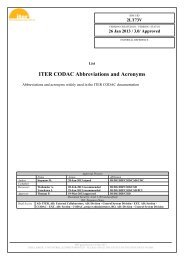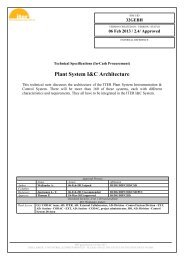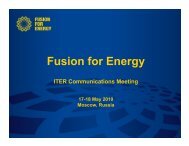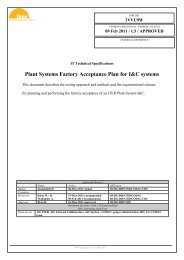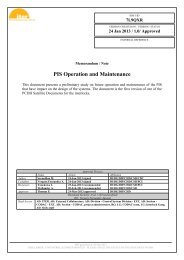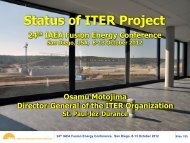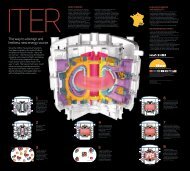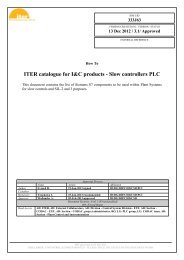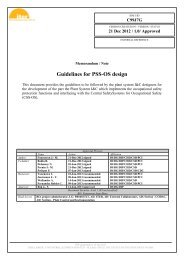SEQA-45 - Software Engineering and Quality Assurance for ... - Iter
SEQA-45 - Software Engineering and Quality Assurance for ... - Iter
SEQA-45 - Software Engineering and Quality Assurance for ... - Iter
Create successful ePaper yourself
Turn your PDF publications into a flip-book with our unique Google optimized e-Paper software.
2.4.1 Acquisition ProcessPurpose:The purpose of the Acquisition Process is to obtain the product <strong>and</strong>/or service that satisfy theneed expressed by the acquirer. The process begins with the identification of customer needs<strong>and</strong> ends with the acceptance of the product <strong>and</strong>/or service needed by the acquirer.Implementation:St<strong>and</strong>ard IO practices apply (defined <strong>and</strong> maintained by the IO Department <strong>for</strong> Administration,Procurement <strong>and</strong> Contract Division). The acquirer acceptance activity in the scope of PCDH isdefined in reference [RD4].2.4.2 Supply ProcessPurpose:The purpose of the Supply Process is to provide a product or service to the acquirer that meetsthe agreed requirements.Implementation:St<strong>and</strong>ard IO practices apply (defined <strong>and</strong> maintained by the IO Department <strong>for</strong> Administration,Procurement <strong>and</strong> Contract Division). The quality requirements <strong>for</strong> procurement are defined inreference [RD5].2.4.3 Life Cycle Model Management ProcessPurpose:The purpose of the Life Cycle Model Management Process is to define, maintain, <strong>and</strong> assureavailability of policies, life cycle processes, life cycle models, <strong>and</strong> procedures <strong>for</strong> use by theorganization with respect to the scope of this International St<strong>and</strong>ard.This process provides life cycle policies, processes, <strong>and</strong> procedures that are consistent with theorganization's objectives, that are defined, adapted, improved <strong>and</strong> maintained to supportindividual project needs within the context of the organization, <strong>and</strong> that are capable of beingapplied using effective, proven methods <strong>and</strong> tools.Implementation:This process is implemented selectively <strong>for</strong> the most important life cycle models, like the I&Clife cycle, documented in the PCDH ([RD1]). The working instrument <strong>for</strong> this process is IDM(see [RD6]).2.4.4 Infrastructure Management ProcessPurpose:The purpose of the Infrastructure Management Process is to provide the enabling infrastructure<strong>and</strong> services to projects to support organization <strong>and</strong> project objectives throughout the life cycle.This process defines, provides <strong>and</strong> maintains the facilities, tools, <strong>and</strong> communications <strong>and</strong>in<strong>for</strong>mation technology assets needed <strong>for</strong> the organization’s business with respect to the scopeof this International St<strong>and</strong>ard.Page 10 of 22


